BEAT THE SWEET
EXPLORING THE INNOVATION AND EFFICACY OF AN ARTIFICIAL PANCREAS IN DIABETES MANAGEMENT
THE SCIENCE OF TODAY IS THE TECHNOLOGY OF TOMORROW
Exploring the potential of artificial pancreas technology in revolutionizing diabetes care
Diabetes is a prevalent chronic condition, exacerbated by sedentary lifestyles and poor diets.
Recent advancements in diabetes management include the innovative artificial pancreas, offering dynamic and precise blood glucose regulation.
Our experiment delves into Introducing an innovative artificial pancreas model designed to autonomously regulate blood glucose levels, potentially transforming diabetes care.
WHAT IS DIABETES



THE PANCREAS
A vital organ of our digestive system, located inside our abdomen just behind the stomach. It is responsible for creation of various enzymes and hormones, primarily insulin, which help break down sugars, fats and starches and help regulate our blood sugar levels and appetite respectively
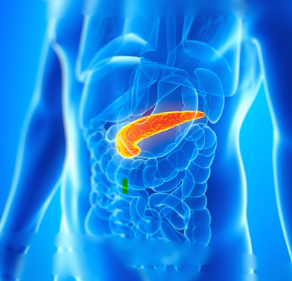
BLOOD GLUCOSE
The main sugar found in our blood which is our body’s primary source of energy. Comes from the food we eat which the body breaks down that food into glucose and releases into our bloodstream
INSULIN
A hormone that lowers the level of blood glucose. It’s made by the BETA cells of the pancreas and released into the blood when the glucose levels in our body go up. It also helps glucose enter the body celld where it can be stored and used for energy.
RESEARCH QUESTION
How does varying the volume of distilled water (Blood glucose) within the range of 10,20,30,40,50ml influence the volume of tap water (Insulin) needed, as measured by voltage output using a multimeter?
PURPOSE
The objective of our experiment is to depict the functionality of the pancreas in the human body by employing a feedback loop model. This project explores a groundbreaking feedback loop system for glucose regulation, simulating natural pancreatic functions. We also understand how blood glucose is created in our body as well as how insulin is secreted in our bloodstream by the pancreas while lowering blood glucose levels.
HYPOTHESIS
Our hypothesis is that if the volume of distilled water increases from 10-50ml then there will be a corresponding increase in the volume of tap water needed to maintain the blood glucose levels, measured by the corresponding values on the multimeter (voltage) because insulin regulates the level of blood glucose.
VARIABLES
INDEPENDENT VARIABLE The volume of distilled water (blood glucose) 10ml,20ml,30ml,40ml,50ml
DEPENDENT VARIABLE The volume of the tap water (insulin) measured using a multimeter in voltage
CONTROLLED VARIABLE The arduino kit, circuit which controls the volume of the tap water, same room temperature
This is a simple headline
ARDUINO-COMPATIBLE MICROCONTROLLER BOARD
USB CABLE
BREADBOARD
JUMPER WIRES
5V PERISTALTIC LIQUID Pump
N-CHANNEL MOSFET
RECOMMENDED: MULTIMETER
BOWLS OR FOOD STORAGE CONTAINERS (2)
ALUMINUM FOIL
TAPE CORKS OR PACKING FOAM
TOOTHPICK
TAP WATER
DISTILLED WATER
FOOD COLORING
DISH TOWELS OR
PAPER TOWELS
FINE-TIPPED PERMANENT MARKER
COMPUTER REQUIREMENTS
A COMPUTER WITH
- Access to the Arduino IDE (either installed local version or web-based editor.)
- USB port. The Science Buddies kit comes with a USB-A to B cable. The “B” end plugs into the Arduino and the “A” end plugs into your computer. You will need an adaptor or different cable if your computer only has USB-C ports.
PROCEDURE
- Build the conductivity sensor using two strips of aluminium foil and a piece of Styrofoam, making the sensor fit in the container filled with water. The idea is to have two strips of aluminum foil, spaced apart by several inches, so they would sit at opposite ends of the water container.
- Make the sensor float so that the amount of submerged surface area on the aluminum foil stays constant while adding the distilled water ( the amount of submerged surface area would affect the voltage reading)
- Fill the other container with 200 ml of tap water. Add a few drops of food coloring to make it easier to distinguish from the distilled water.
- Immerse a pump attached to the Arduino kit connected to the container filled with distilled water. Measure the voltage on multimeter.
- Add tap water (insulin) to the distilled water. Record the change in the voltage on multimeter.
- Repeat the experiment 5 times by changing the volume of the distilled water & corresponding addition of tap water. Record the change in the voltage output.
7. Finally draw the table, process the data and plot the graph.
PERFORMING THE EXPERIMENT
SCAN ME

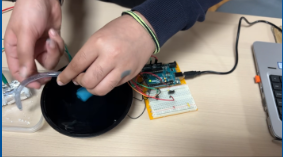
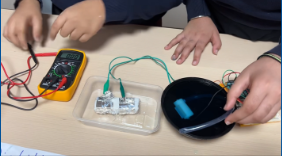
Data
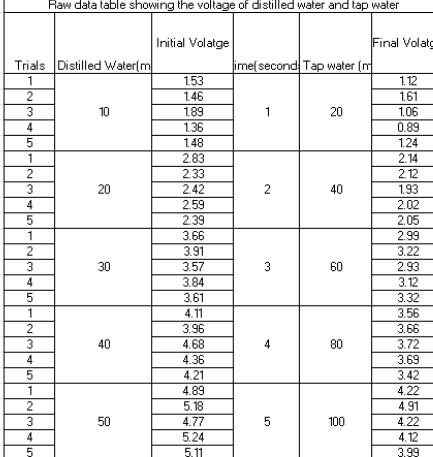
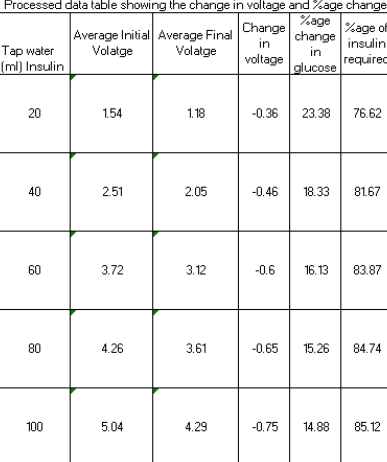
GRAPH
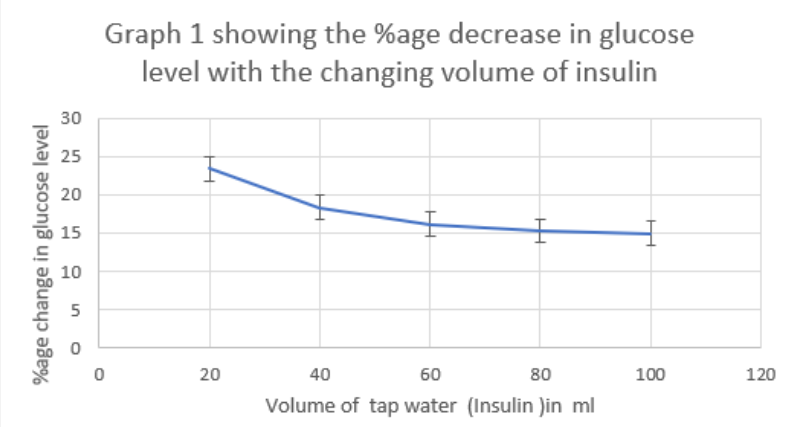
INTERPRETATION & ANALYSIS
- The initial voltage reading of plain distilled water, which serves as an indicator for blood glucose level, is given in column 1 of the table.
2. When 10 ml of distilled water with a voltage reading of 1.5v is mixed with tap water for 1 second, the voltage reading drops to an average of 1.04v.
3. Further experiments were conducted by increasing the amount of distilled water by 10 ml and the duration of the tap water dispensation was increased by 1 second.
4. It was observed that each addition of tap water to distilled water led to a 69-85% decrease in voltage reading.
5. Our model uniquely combines technology and biology, providing continuous glucose monitoring and insulin delivery, reducing patient intervention.
7. The voltage reading (V) obtained from the sensor is a representation of blood glucose levels.
6. NOTE – The Adruino model used by us is designed to dispense 20 ml of tap water (insulin) every second.
RESULTS
RESULTS
- The outcome of our experiment aligned with our expectation. The experiment involving the artificial pancreas mirrors the functioning of the human pancreas.
2 In response to rising blood sugar levels, the pancreas secretes insulin, which effectively lowers these levels.
3. Similarly, in our experiment, the voltage reading decreased upon the introduction of tap water.
4. No unexpected occurrences were noted.
5. Moving forward, we aim to progress with the experiment to investigate the artificial pancreas’s response to a continual decrease in blood sugar levels. How would the artificial pancreas manage this scenario?
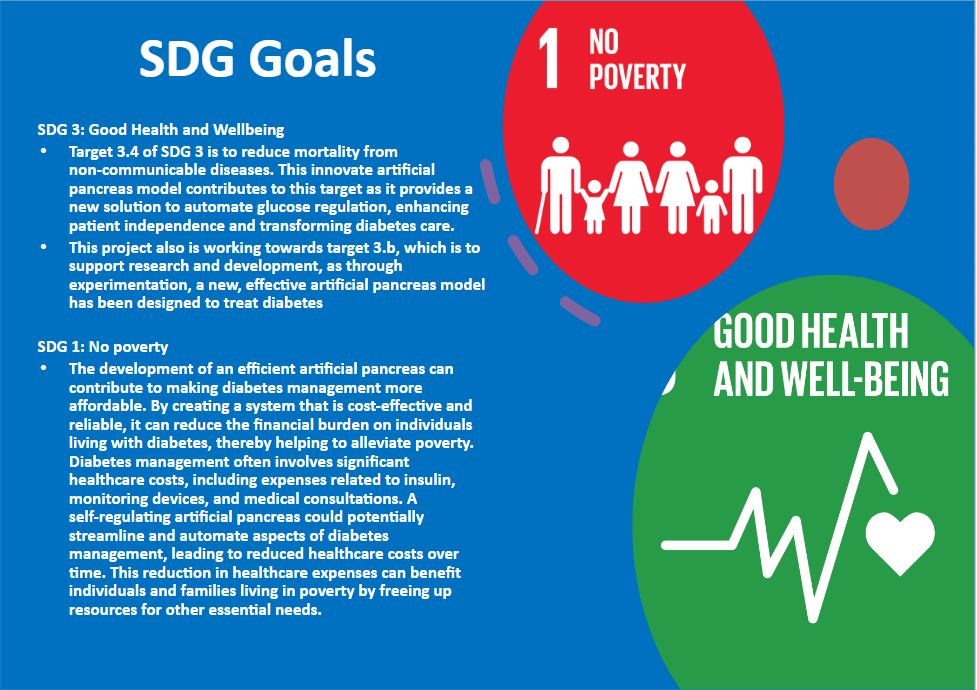
SDG Goals
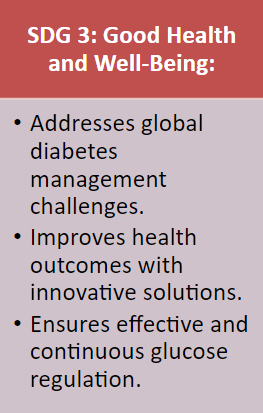
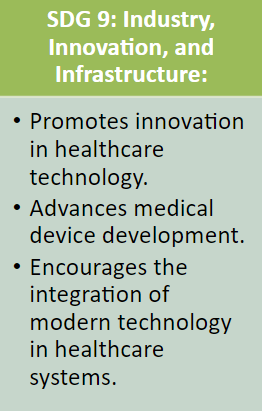

CONCLUSION
In conclusion, our science experiment not only validates the potential of the artificial pancreas but also highlights an innovative approach in diabetes management. By automating glucose regulation, this concept could significantly enhance patient independence and transform diabetes care. This aligns with SDG 3: Good Health and Well-Being, emphasizing the critical role of innovation in achieving sustainable health solutions.
